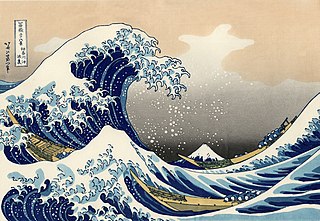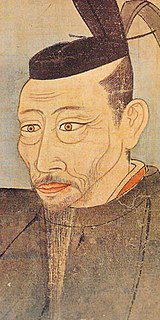
Toyotomi Hideyoshi was a preeminent daimyō, warrior, general, samurai, and politician of the Sengoku period who is regarded as Japan's second "great unifier". He succeeded his former liege lord, Oda Nobunaga, and brought an end to the Warring Lords period. The period of his rule is often called the Momoyama period, named after Hideyoshi's castle. After his death, his young son Hideyori was displaced by Tokugawa Ieyasu.
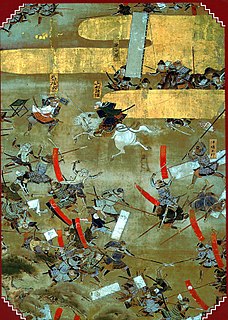
The Sengoku period is a period in Japanese history marked by social upheaval, political intrigue and near-constant military conflict. Japanese historians named it after the otherwise unrelated Warring States period in China. It was initiated by the Ōnin War, which collapsed the Japanese feudal system under the Ashikaga shogunate, and came to an end when the system was re-established under the Tokugawa shogunate by Tokugawa Ieyasu.
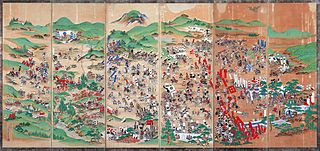
The Battle of Sekigahara was a decisive battle on October 21, 1600, that preceded the establishment of the Tokugawa shogunate.

The Siege of Osaka was a series of battles undertaken by the Tokugawa shogunate against the Toyotomi clan, and ending in that clan's destruction. Divided into two stages, and lasting from 1614 to 1615, the siege put an end to the last major armed opposition to the shogunate's establishment. The end of the conflict is sometimes called the Genna Armistice, because the era name was changed from Keichō to Genna immediately following the siege.

Bizen Province was a province of Japan on the Inland Sea side of Honshū, in what is today the southeastern part of Okayama Prefecture. It was sometimes called Bishū (備州), with Bitchū and Bingo Provinces. Bizen borders Mimasaka, Harima, and Bitchū Provinces.

Kobayakawa Hideaki was the fifth son of Kinoshita Iesada and the nephew of Toyotomi Hideyoshi.

The Council of Five Elders, was a group of five powerful feudal lords formed in 1598 by the Regent Toyotomi Hideyoshi, shortly before his death in the same year. While Hideyoshi was on his deathbed, his son, Toyotomi Hideyori, was still only 5 years old and as such Hideyoshi needed to create the council in order to ensure his heir would be able to succeed him after coming of age. They also acted as advisers for the Five Commissioners, which had also been established by Hideyoshi to govern Kyoto and the surrounding areas.
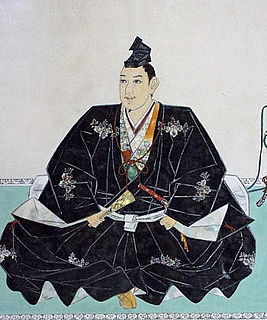
Ukita Hideie was the daimyō of Bizen and Mimasaka Provinces, and one of the council of Five Elders appointed by Toyotomi Hideyoshi. Son of Ukita Naoie, he married Gōhime, a daughter of Maeda Toshiie. Having fought against Tokugawa Ieyasu in the Battle of Sekigahara he was exiled to the island prison of Hachijō-jima, where he died.

Fudai daimyō (譜代大名) was a class of daimyōs who were hereditary vassals of the Tokugawa in Edo-period Japan. It was primarily the fudai who filled the ranks of the Tokugawa administration.
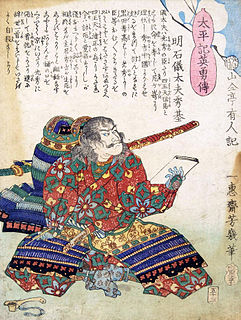
Akashi Takenori was a Japanese samurai of the Azuchi-Momoyama through early Edo periods. Also known as Teruzumi, Zentō, or Naritoyo. Retainer of Ukita Naoie, the major daimyō of Bizen Province. Also known by his court title, Kamon-no-Kami (掃部頭). Takenori also served as a strategist under Naoie's son Ukita Hideie. At the Battle of Sekigahara, he fought bravely against Fukushima Masanori. After the Ukita clan had been destroyed in the Battle of Sekigahara, Akashi vanished. At the Siege of Osaka, Akashi entered Osaka castle and he fought against Tokugawa Ieyasu to the last minute. After the castle's fall, he escaped again. He never committed suicide because of his Christian beliefs. Despite being hunted by the forces of Tokugawa Ieyasu, he was not caught; his whereabouts after the battle are unknown.

Kira Pika (きら☆ぴか) was a Japanese pop music duo that was part of the Hello! Project collective created for the anime Kirarin Revolution in 2007. The members consisted of Koharu Kusumi from Morning Musume and Mai Hagiwara from Cute, who voiced Kirari Tsukishima and Hikaru Mizuki in the show. The name of the group is a portmanteau of the characters' names.
Date Hidemune was a Japanese daimyō of the early Edo period. He was the eldest son of Date Masamune, born in 1596 by Shinzo no Kata. Coming of age while living with Toyotomi Hideyoshi, he received a character from Hideyoshi's name and took the adult name of Hidemune. Hideyoshi also granted him the court rank of junior 5th, lower grade and the title of ji-jū, appointing the young Hidemune as a page to his own son Toyotomi Hideyori. After Hideyoshi's death in 1600, he was made a hostage at the residence of Ukita Hideie.

Okazaki Domain was a feudal domain of the Tokugawa shogunate in Edo period, Japan located in eastern Mikawa Province, Japan. It was centered on Okazaki Castle in what is now the city of Okazaki, Aichi. It was ruled by a number of different fudai daimyō over the course of the Edo period. Due to its associations with Tokugawa Ieyasu, who was born in Okazaki Castle, the domain had a prestige greater than in its nominal valuation based on rice tax revenues.
Kamei Masanori was a Japanese daimyō of the early Edo period. He was the head of the Tsuwano Domain.
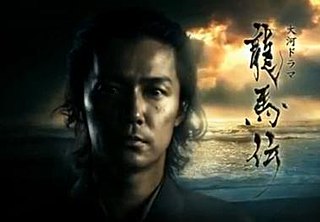
Ryōmaden (龍馬伝) is the 49th NHK Taiga drama. It was shown on NHK from January 3 to November 28, 2010, spanning 48 episodes. The story centers on the life of 19th-century Japanese historical figures Iwasaki Yatarō and Sakamoto Ryōma. It has been announced that the series will be aired in several other countries, for example Hong Kong, South Korea, Taiwan and Thailand.
Naomori is a masculine Japanese given name. Notable people with the name include:
Kazuhiko Sakazaki was a Japanese baseball player who played as an outfielder.

Takasaki Domain was a feudal domain under the Tokugawa shogunate of Edo period Japan, located in Kōzuke Province, Japan. It was centered on Takasaki Castle in what is now part of the city of Takasaki, Gunma. Takasaki was ruled through most of its history by a junior branch of the Matsudaira clan.
Tsuwano Castle was a mid-size castle, now ruins, in Tsuwano, Shimane Prefecture, Japan.


